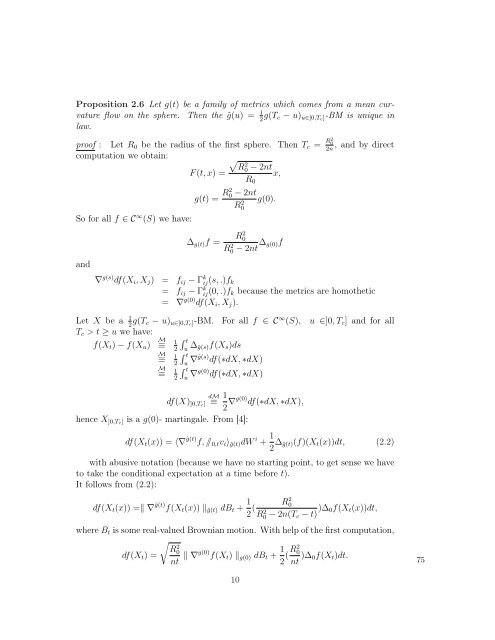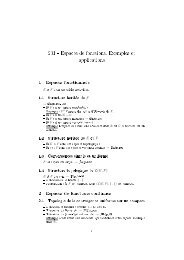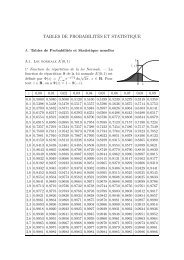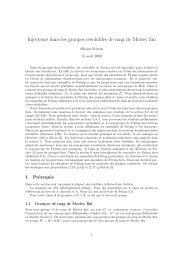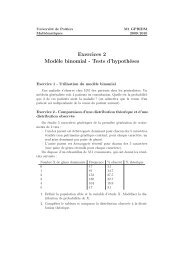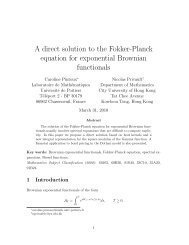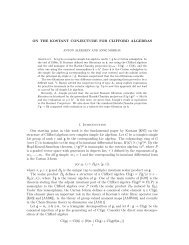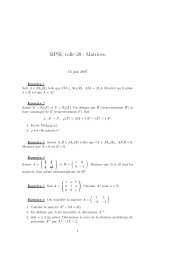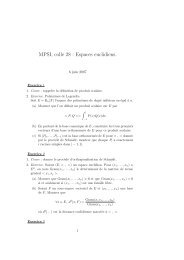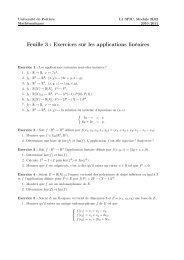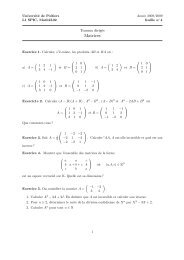Proposition 2.5 Let ϕ = (ɛ k ) k → 0, and X ϕ ]0,T , s.t. c] Xɛ k L]0,T c]→ X ϕ ]0,T . c]X ϕ ]0,T is a 1g(T c] 2 c − t)-BM in the following sense:Then.∀ɛ > 0 X ϕ [ɛ,T c]L= BM(ɛ, X ϕ ɛ )proof : Let ɛ > 0 then for large k:⎧⎨ X ɛ k is a BM(ɛ, Xɛ kɛ ) after time ɛ , by Markov property⎩and let X be a BM(ɛ, X ϕ ) after time ɛɛWe want to show that X = X ϕ after ɛ . So for sketch of the proof:X ɛ kso X ɛ kɛL−→k→∞ XϕL−→k→∞ Xϕ ɛ ,we use the Skorokhod theorem, to have a L 2 -convergence in a larger probabilityspace:X ′ ɛ kL 2 ,a.s.ɛ −→ X ′ ϕɛ ,k→∞Lwith X ′ ɛ kɛ = X ɛ kɛ and X ′ ϕ Lɛ = Xɛ ϕ . We use convergence of solution of S.D.E withinitial conditions converging in L 2 (e.g. in Stroock and Varadhan [22]), to get:We use thatBM(ɛ, X ′ ɛ kLɛ ) −→ BM(ɛ, X ′ ϕɛ ),k→∞BM(ɛ, X ′ ɛ kɛ ) = L X ɛ k[ɛ,T , c]BM(X ′ ϕɛ ) L = BM(ɛ, X ϕ ɛ ).X ɛ kL−→k→∞ Xϕto conclude, after identification of the limit:X = BM(ɛ, X ϕ ɛ ) L = X ϕ [ɛ,T c] .Hence the process X ϕ is a 1 2 g(T c − u) u∈]0,Tc]-BM in the above sense, we call it"without birth" .We now show that, in the sphere case, the 1 2 g(T c − u) u∈]0,Tc]-BM is, after achange of time, nothing else than a BM(g(0)) ]−∞,0] , this will give uniqueness inlaw of such process.749
Proposition 2.6 Let g(t) be a family of metrics which comes from a mean curvatureflow on the sphere. Then the ˜g(u) = 1g(T 2 c − u) u∈]0,Tc]-BM is unique inlaw.proof : Let R 0 be the radius of the first sphere. Then T c = R2 0, and by direct2ncomputation we obtain:√R2F (t, x) = 0 − 2ntx,R 0So for all f ∈ C ∞ (S) we have:g(t) = R2 0 − 2ntg(0).R02and∆ g(t) f =R 2 0R 2 0 − 2nt ∆ g(0)f∇ g(s) df(X i , X j ) = f ij − Γ k ij(s, .)f k= f ij − Γ k ij(0, .)f k because the metrics are homothetic= ∇ g(0) df(X i , X j ).Let X be a 1g(T 2 c − u) u∈]0,Tc]-BM. For all f ∈ C ∞ (S), u ∈]0, T c ] and for allT c > t ≥ u we have:M ∫f(X t ) − f(X u ) ≡1 t ∆˜g(s)f(X 2 u s )dsM ∫≡1 t ∇˜g(s) df(∗dX, ∗dX)2 u∫ tu ∇g(0) df(∗dX, ∗dX)M≡12dM 1df(X) ]0,Tc] ≡2 ∇g(0) df(∗dX, ∗dX),hence X ]0,Tc] is a g(0)- martingale. From [4]:df(X t (x)) = 〈∇˜g(t) f, / 0,t v i 〉˜g(t) dW i + 1 2 ∆˜g(t)(f)(X t (x))dt, (2.2)with abusive notation (because we have no starting point, to get sense we haveto take the conditional expectation at a time before t).It follows from (2.2):df(X t (x)) =‖ ∇˜g(t) f(X t (x)) ‖˜g(t) dB t + 1 2 ( R 2 0R 2 0 − 2n(T c − t) )∆ 0f(X t (x))dt,where B t is some real-valued Brownian motion. With help of the first computation,df(X t ) =√R20nt ‖ ∇g(0) f(X t ) ‖ g(0) dB t + 1 2 (R2 0nt )∆ 0f(X t )dt.7510
- Page 1:
Université de PoitiersTHÈSEpour o
- Page 4 and 5:
AbstractIn the first part of this t
- Page 6 and 7:
ivTABLE DES MATIÈRES3 Kendall-Cran
- Page 8 and 9:
8 CHAPITRE 1. INTRODUCTIONdifféren
- Page 10 and 11:
10 CHAPITRE 1. INTRODUCTIONdonne se
- Page 12 and 13:
12 CHAPITRE 1. INTRODUCTIONHamilton
- Page 14 and 15:
14 CHAPITRE 1. INTRODUCTIONx et ell
- Page 16 and 17:
16 CHAPITRE 1. INTRODUCTIONCette é
- Page 18 and 19:
18 CHAPITRE 1. INTRODUCTION- Exempl
- Page 20 and 21:
20 CHAPITRE 1. INTRODUCTION20
- Page 22 and 23:
22CHAPITRE 2. INTRODUCTION À L’A
- Page 24 and 25: 24CHAPITRE 2. INTRODUCTION À L’A
- Page 26: 26CHAPITRE 2. INTRODUCTION À L’A
- Page 29 and 30: 2. ÉQUATIONS DIFFÉRENTIELLES STOC
- Page 31 and 32: 2. ÉQUATIONS DIFFÉRENTIELLES STOC
- Page 33 and 34: 3. QUELQUES APPLICATIONS DU CALCUL
- Page 35 and 36: Chapitre 3Brownian motion with resp
- Page 37 and 38: for every smooth function f,is a lo
- Page 39 and 40: For the solution U t of (1.1) we ge
- Page 41 and 42: Remark : Recall that in the compact
- Page 43 and 44: 2 Local expression, evolution equat
- Page 45 and 46: The last equality comes from Green
- Page 47 and 48: Theorem 3.2 For every solution f(t,
- Page 49 and 50: Consequently:d(df(T − t, .) X Tt
- Page 51 and 52: Proof : The first remark after theo
- Page 53 and 54: Remark : Hamilton gives a proof of
- Page 55 and 56: Corollary 3.7 For χ(M) < 0, there
- Page 57 and 58: We also have:D S,T −t dπ ˜// 0,
- Page 59 and 60: Proof : By differentiation under x
- Page 61 and 62: where we have used in the second eq
- Page 63 and 64: [10] K. D. Elworthy and M. Yor. Con
- Page 65 and 66: Chapter 4Some stochastic process wi
- Page 67 and 68: We will just look at the smooth sol
- Page 69 and 70: that is to say:d(Y T,it ) = − ∂
- Page 71 and 72: 2 Tightness, and first example on t
- Page 73: proof : It is clear that F is smoot
- Page 77 and 78: v) ˜g(∞) is a metric such that (
- Page 79 and 80: Then:for all ɛ > 0 , there exists
- Page 81 and 82: Finally, we obtain:∂∂t | t=t 0
- Page 83 and 84: where Ut 3 is the horizontal lift o
- Page 85 and 86: √πWe can choose ɛ, ɛ 2 such th
- Page 87 and 88: We will now show that the coupling
- Page 89 and 90: HenceWe get:√√ n∑1 − ɛI t
- Page 91 and 92: By uniqueness in law of such proces
- Page 95 and 96: Chapter 5Horizontal diffusion in pa
- Page 97 and 98: 2 M. ARNAUDON, A. K. COULIBALY, AND
- Page 99 and 100: 4 M. ARNAUDON, A. K. COULIBALY, AND
- Page 101 and 102: 6 M. ARNAUDON, A. K. COULIBALY, AND
- Page 103 and 104: 8 M. ARNAUDON, A. K. COULIBALY, AND
- Page 105 and 106: 10 M. ARNAUDON, A. K. COULIBALY, AN
- Page 107 and 108: 12 M. ARNAUDON, A. K. COULIBALY, AN
- Page 109 and 110: 14 M. ARNAUDON, A. K. COULIBALY, AN
- Page 111 and 112: 16 M. ARNAUDON, A. K. COULIBALY, AN
- Page 113 and 114: Chapter 6Compléments de calculs113
- Page 115 and 116: d’avoir une famille de connexion,
- Page 117 and 118: Dans le calcul de ligne 8 à ligne
- Page 119 and 120: On utilise le fait que W (.) t est
- Page 121 and 122: Chapter 7Appendix121121
- Page 123 and 124: 774 M. Arnaudon et al. / C. R. Acad
- Page 125 and 126:
776 M. Arnaudon et al. / C. R. Acad
- Page 127 and 128:
778 M. Arnaudon et al. / C. R. Acad
- Page 129 and 130:
Bibliography[ABT02]Marc Arnaudon, R
- Page 131 and 132:
BIBLIOGRAPHY 131[DeT83][Dri92]Denni
- Page 133 and 134:
BIBLIOGRAPHY 133[Jos84][Jos05][JS03
- Page 135 and 136:
135


